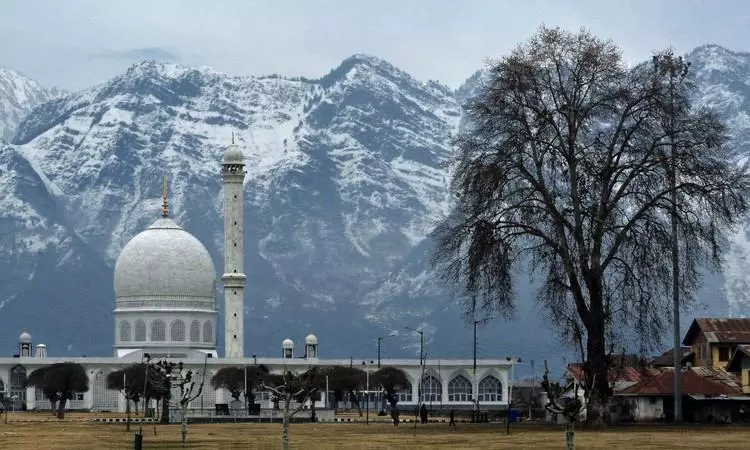
- Home
- India
- World
- Premium
- THE FEDERAL SPECIAL
- Analysis
- States
- Perspective
- Videos
- Sports
- Education
- Entertainment
- Elections
- Features
- Health
- Business
- Series
- In memoriam: Sheikh Mujibur Rahman
- Bishnoi's Men
- NEET TANGLE
- Economy Series
- Earth Day
- Kashmir’s Frozen Turbulence
- India@75
- The legend of Ramjanmabhoomi
- Liberalisation@30
- How to tame a dragon
- Celebrating biodiversity
- Farm Matters
- 50 days of solitude
- Bringing Migrants Home
- Budget 2020
- Jharkhand Votes
- The Federal Investigates
- The Federal Impact
- Vanishing Sand
- Gandhi @ 150
- Andhra Today
- Field report
- Operation Gulmarg
- Pandemic @1 Mn in India
- The Federal Year-End
- The Zero Year
- Science
- Brand studio
- Newsletter
- Elections 2024
- Events
- Home
- IndiaIndia
- World
- Analysis
- StatesStates
- PerspectivePerspective
- VideosVideos
- Sports
- Education
- Entertainment
- ElectionsElections
- Features
- Health
- BusinessBusiness
- Premium
- Loading...
Premium - Events

By using the emblem within a mosque, did not the Waqf Board denigrate the State Emblem of India, used strictly on official documents and sites?
The renewed call by the BJP for stern action against those who allegedly vandalised the Indian State Emblem — also called the Ashoka National Emblem — inside the Hazratbal shrine in Srinagar last week, has given a fresh wind to the highly avoidable controversy.
This underscores once more that the entire episode wherein the national emblem was defaced by a group of people, incensed on seeing that the inauguration plaque was prominently inscribed with the emblematic lions, was little but the BJP’s self-wrought crisis.
The avoidable episode has been needlessly heaped upon the people and the embittered region by a local politician and her coterie, with absolutely no mass following among people and instead carries the backing of the country's current political regime.
Also read: Over 50 detained for Hazratbal Ashoka Emblem vandalism
Pleasing the masters
To ensure a pat on the back from the Centre and the BJP leadership, in the absence of support within the Union Territory of Jammu and Kashmir, especially the Valley region, this group led by J&K Waqf Board chairperson Darakhshan Andrabi committed a highly questionable act in the hope that it would ‘please’ the political masters in New Delhi.
The decision to foist the emblem on the Dargah betrayed scant regard for the fact that Kashmiri people see the Hazratbal shrine not just as a spiritual embodiment, but also as a memory of their collective power of resistance to State might.
To this ‘blasphemy’, one can do little but add the call of the J&K BJP president, Sat Sharma, for stern action against the people who have been identified on the basis of available videos and CCTV footage.
It was initially reported that on the footing of their preliminary investigations, the local police detained more than 50 people, but there is little news update thereafter regarding their current fate.
Also read: Farooq Abdullah ‘stopped’ at Hazratbal; Mehbooba calls it Centre’s ‘iron fist'
Call for stern action a concern
Sharma’s demand for action against this lot is particularly worrisome because it invokes the party’s pseudo-nationalistic plank. The implicit plea to the Centre’s representatives is that they should be charged under the draconian Public Safety Act, which virtually makes bail impossible.
Without going into the appropriateness of the decision taken by Andrabi and other functionaries of the Waqf Board to inscribe the plaque installed inside the mosque, with the symbolic Ashoka Emblem, Sharma has made a completely vacuous assertion that "it is the duty of every citizen to safeguard the Constitution of the country and its symbols".
Also read: National emblem only for govt functions, says JK CM after Hazratbal mosque row
No one would deny this assertion, but should not a more substantial question be asked prior to Sharma’s standard pillorying of unnamed people who allegedly defiled the emblem?
An emblem in a mosque
By using the emblem within a mosque, did not the Waqf Board denigrate the State Emblem of India, used strictly on official documents, currency, passports and other official sites? Furthermore, the shrine in question is no ordinary mosque and instead is the Hazratbal Dargah, the most revered shrine in Kashmir, which has been the cause of much strife whenever people felt it was blasphemed.
People in Kashmir eagerly awaited the completion of the Dargah’s renovation, which has been undertaken for the past year under the aegis of the Waqf Board.
Also read: 'Inconsiderate, deliberate,' says Omar Abdullah as J&K admin refuses to shift Eid holiday
The announcement that it would be once again thrown open to the public in early September on the eve of Eid-Milad un-Nabi, the birth anniversary of Prophet Muhammad, whose relic is believed to be housed inside, had raised expectations of the people.
J&K Chief Minister Omar Abdullah categorically stated that the Waqf Board should apologise for its “mistake”. According to him, the national emblem is strictly meant for government functions and not religious institutions.
Andrabi is the first and only woman chairperson of a Waqf Board in India, and onlookers were initially awestruck when they realised that what had previously been staid walls of the Dargah were now replaced by local crafts, Islamic inscriptions and interiors lit up by dancing lights managed by the latest technological gizmos.
Prior to the formal inauguration of the shrine by Andrabi, Union Minister of Minority Affairs, Kiren Rijiju, visited the shrine and congratulated her, in the process reinforcing the belief that the entire project was part of the BJP’s political outreach to a community that remains alienated from the party and the Centre, despite its claims to the contrary.
Why people got angry
But the moment people saw the plaque holding information about the renovation, their anger spilled out in the open. They accused the Waqf Board of hurting their religious sentiments and damaged the emblem on the plaque.
Also read: Supreme Court seeks Centre's response on J-K statehood restoration plea
Quite clearly, the Ashoka Emblem was perceived by the people as an attempt to convey that the shrine was yet another ceremonial ‘office’ of the Indian State.
The decision to foist the emblem on the Dargah betrayed scant regard for the fact that the Kashmiri people see the Hazratbal shrine not just as a spiritual embodiment, but also as a memory of their collective power of resistance to State might.
Bad decisions
Affixing India’s official emblem inside the shrine was unprecedented and the response of the people was no different from what would have been the reaction had a similar act been committed on the Harmandir Sahib (Golden Temple), Amritsar, during the turbulent years in the 1980s and 1990s, especially after the badly damaged shrine was thrown open following repair and renovation post Operation Blue Star.
Also read: Ladakh statehood: Sonam Wangchuk begins 35-day fast in Leh
Likewise, the response of the people would have been equally hostile if devotees saw the Ashoka Emblem inside the Ram temple in Ayodhya after its consecration in January 2024.
In fact, it was an error on the part of the state administration to nominate Andrabi to the position even though she was part of the leadership of the state BJP. Having her at the head of the Waqf Board left the field open for people to level accusations that the Centre used its political and administrative authority to steamroll people's religious sensibilities.
Politicians fuel resentment
The anger of the people was also backed by various political leaders. Most importantly, J&K Chief Minister Omar Abdullah categorically stated that the Waqf Board should apologise for its “mistake”. According to him, the national emblem is strictly meant for government functions and not religious institutions.
Without mincing his words, Abdullah asserted that he had “never seen an emblem being used in this way in any religious place.”
Also read: Political dimensions of Omar’s J-K statehood signature campaign | Capital Beat
According to him, mosques, dargahs, temples and gurudwaras are not government institutions. “These are religious institutions, and government emblems are not used in religious institutions,” he added
His sentiments were voiced somewhat similarly by former chief minister Mehbooba Mufti and other leaders of the PDP and the CPI(M). Ever since August 2019, when J&K’s special status was erased overnight and the entire power of governance and law and order was vested in the Centre, the UT has vacillated between being in a state of ‘nervous’ tranquillity and lurching on the verge of a precipice.
Selection of officers
The emblematic thumbprint of the Centre or the Indian State came quickly in succession to the UT administration’s decision to virtually place the entire political leadership, including CM Abdullah and all other important leaders, including Mufti, under de facto house arrest on July 13 — also marked as Martyr’s Day by the local people and their representatives.
Despite the Narendra Modi regime’s penchant for an over-centralised decision-making process, quite clearly, it is not possible to keep watch over every act of its representatives in every nook and corner of the country, especially the troubled spots.
Given that, the process of selection of people to key positions needs to be more judicious, and those eager to curry favour with the leadership should be kept at an arm’s distance.
As far as the immediate crisis is concerned, the BJP’s central leadership and its key representatives in government would do well by diffusing the situation.
This would be best done by taking no further precipitous action and simultaneously tightening the reins on the likes of Sharma. As far as Andrabi is concerned, it would be best for the leadership to get her to heed the demands from large sections of people and their representatives for her to express regret for the decision to emboss the official emblem on the shrine.
(The Federal seeks to present views and opinions from all sides of the spectrum. The information, ideas or opinions in the articles are of the author and do not necessarily reflect the views of The Federal.)


